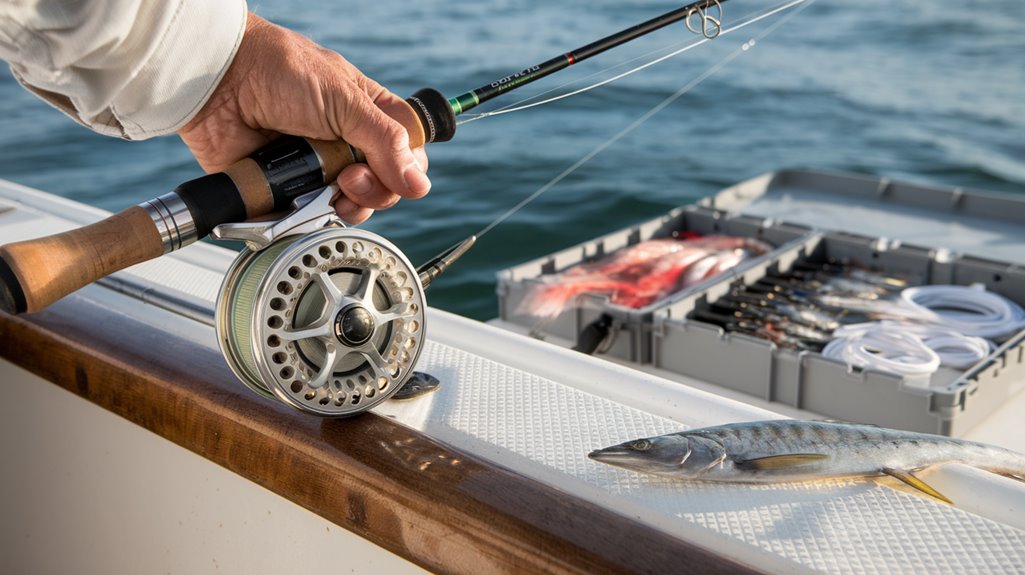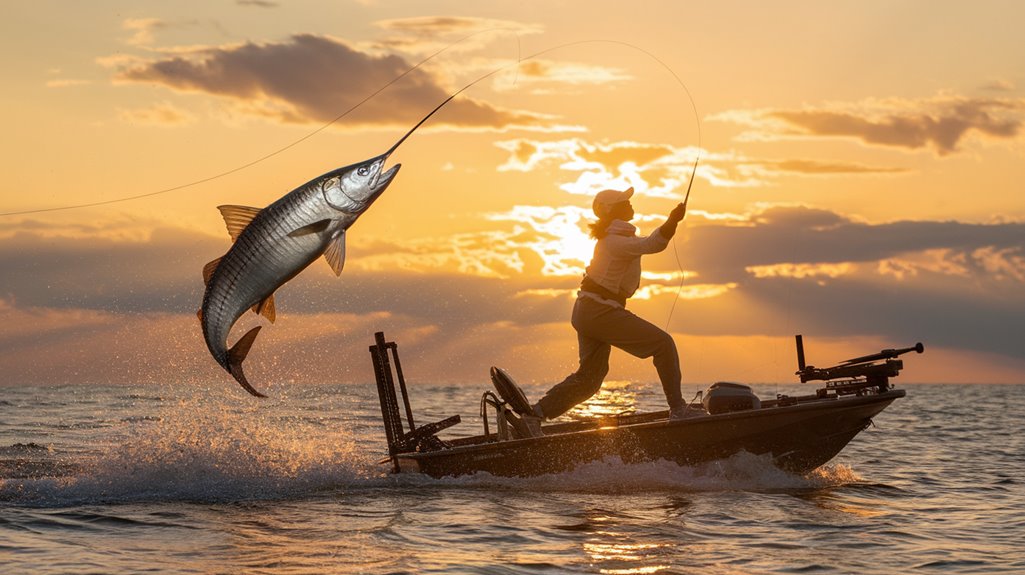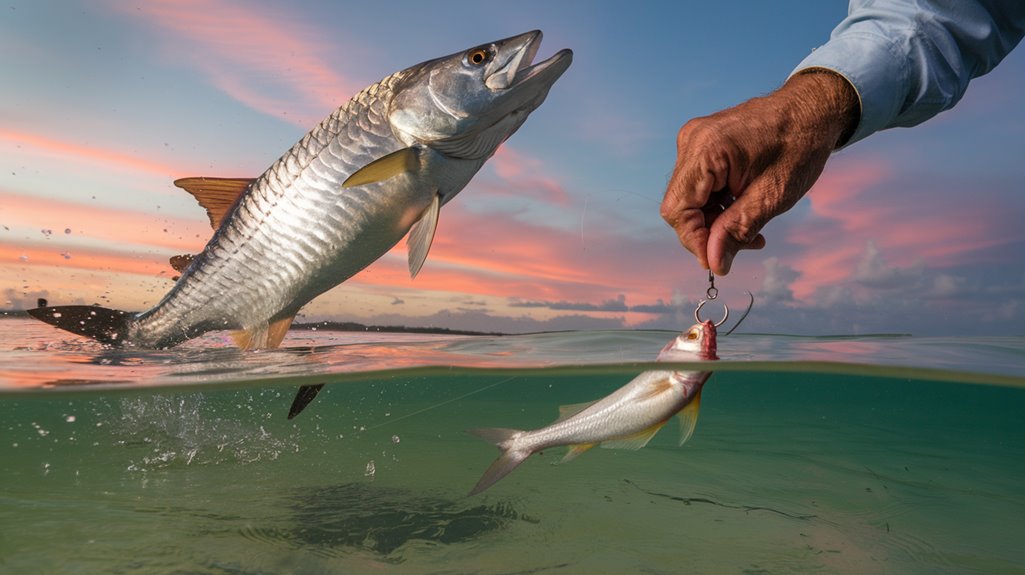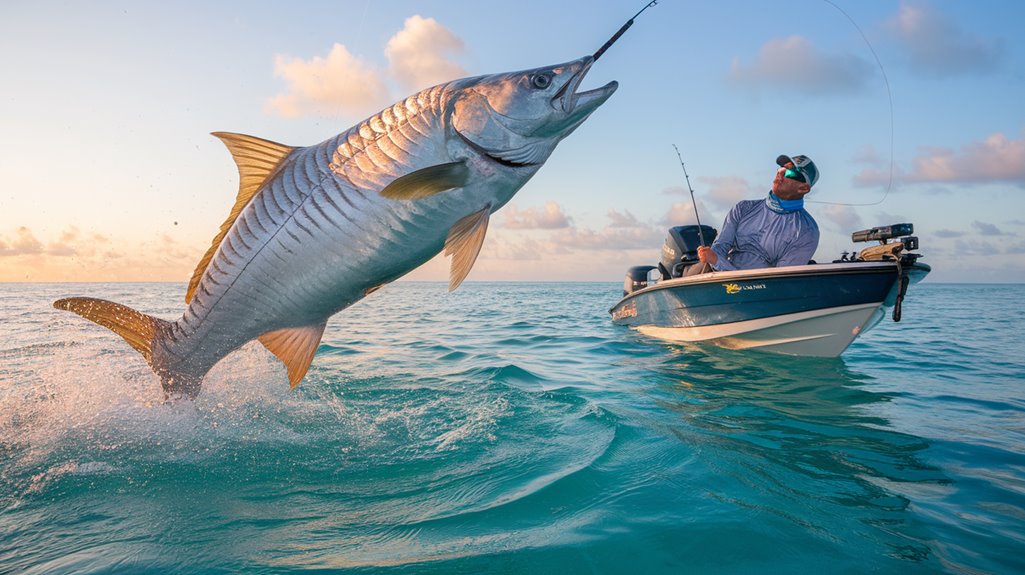If you've dreamed of landing a silver king, you'll need more than basic fishing skills and standard gear. Professional guides have spent decades perfecting their tarpon techniques, learning the subtle differences between success and failure on the water. From precise bait presentation to understanding the intricate dance of tides and moon phases, there's a wealth of proven strategies that separate casual anglers from consistent tarpon catchers. Let's reveal these closely guarded secrets.
- Key Takeaways
- Essential Gear and Equipment Setup
- Understanding Tarpon Behavior Patterns
- Advanced Casting Techniques and Strategies
- Reading Weather and Water Conditions
- Best Practices for Live Bait Presentation
- Professional Guide Communication Tips
- Proven Fighting and Landing Methods
- Conservation and Ethical Handling Guidelines
- Frequently Asked Questions
- Conclusion
Key Takeaways
- Target tarpon during outgoing tides at dawn or dusk when they actively feed on baitfish in deeper waters.
- Use a medium-heavy rod with 30-pound fluorocarbon leader and circle hooks sized 3/0 or larger for optimal hookups.
- Master the double haul casting technique and position live bait 2-3 feet below surface for natural presentation.
- Maintain steady drag pressure during fights, timing your reels with the fish's pauses to efficiently land tarpon.
- Handle tarpon with protective gloves and support them horizontally during release to ensure their survival.
Essential Gear and Equipment Setup

When pursuing the mighty tarpon, having the right gear setup can make the difference between landing your trophy and losing it at boatside. Your essential gear should start with a medium-heavy rod paired with a 5000 spinning reel, or if you're fly fishing, opt for a 10-12 weight rod. You'll need a fluorocarbon leader rated at least 30 pounds to handle the tarpon's abrasive mouth and guarantee solid hook sets.
Don't skimp on hook size – use circle hooks no smaller than 3/0 to maximize your hookup chances while protecting the fish. Stock your tackle box with live baits like crabs, pilchards, shrimp, and mullet, or choose artificial options like topwater lures and swimbaits. Remember to pack protective gloves for safe handling during the catch and release process.
Understanding Tarpon Behavior Patterns
With your gear properly set up, let's focus on the fascinating behavior patterns of tarpon – the key to consistently finding and catching these magnificent gamefish. You'll notice these intelligent predators are most active during the outgoing tide when they ambush baitfish in deeper waters. During warmer months, particularly April through June when waters exceed 75 degrees, they'll move inshore and become more accessible to anglers.
- Look for rolling or jumping activity near the surface, which signals active feeding on crabs and small fish
- Plan your fishing trips around dawn or dusk when tarpon feel more secure and are likely to strike
- Focus on productive areas like mangrove shorelines and deep water cuts where tarpon naturally congregate
Understanding these behavioral patterns will greatly increase your chances of success when targeting these cautious fighters.
Advanced Casting Techniques and Strategies

Successful tarpon fishing demands mastery of advanced casting techniques that'll give you a decisive edge on the water. The double haul technique is essential for generating the line speed you'll need to reach distant tarpon, especially in challenging wind conditions. When presenting your tarpon fly, you'll want to incorporate quick false casts to manage your line and achieve precise placement.
Your casting approach must adapt to varying wind conditions while maintaining stealth. When using weighted flies, focus on delivering soft, accurate presentations that won't spook these wary predators. To improve your hook-up success rate, develop a consistent strip set technique that matches the tarpon's aggressive runs. These refined skills will greatly enhance your ability to connect with more fish during vital feeding periods.
Reading Weather and Water Conditions
Beyond mastering your casting technique, reading weather and water conditions holds the key to consistently landing tarpon. You'll find these predators most active when water temperature stays above 75 degrees Fahrenheit, triggering their natural migratory patterns. Focus your efforts during the outgoing tide, when baitfish get pushed toward shore, creating prime feeding opportunities.
Keep an eye on these critical conditions for ideal success:
- Light winds for better visibility and precise casting control
- Overcast skies, which reduce fish skittishness and encourage aggressive feeding
- Dropping barometric pressure, signaling potential feeding frenzies before storms
Monitor these elements carefully, and you'll greatly increase your chances of connecting with trophy tarpon. Remember, successful anglers don't just cast well—they understand and adapt to nature's signals.
Best Practices for Live Bait Presentation

When you're rigging live mullet or pilchards for tarpon, thread your 3/0 or larger circle hook through the bait's nose to maintain its natural swimming action while free-lining. You'll want to position your bait so it drifts naturally with the current, allowing it to struggle and flash in a way that triggers a tarpon's predatory response. Proper hook selection is critical for both securing your catch and protecting the fish, so match your hook size to your bait – use 3/0 to 5/0 for smaller pilchards and up to 7/0 for larger mullet.
Proper Bait Rigging Techniques
Proper rigging of live bait stands as the cornerstone of effective tarpon fishing. You'll want to start with a circle hook no smaller than 3/0, securing your bait through the back or nostrils for maximum liveliness. When targeting silver kings, use a 30-pound fluorocarbon leader to maintain stealth while ensuring enough strength to land these powerful fighters.
- Position your bait 2-3 feet below the surface during outgoing tides, when tarpon are actively feeding
- Free-line your live mullet or pilchards to achieve the most natural presentation
- Consider adding a tarpon toad as a backup attractor when the bite slows
Remember to maintain constant tension on your line while free-lining, allowing the bait to swim naturally and entice those aggressive strikes that make tarpon fishing so thrilling.
Natural Movement While Drifting
To master live bait presentation while drifting for tarpon, you'll need to perfect the delicate balance between boat control and natural bait movement. Position yourself upstream and let the water's current do the work, allowing your bait to drift naturally into prime tarpon feeding zones.
| Key Factor | Impact on Fishing for Tarpon |
|---|---|
| Tide Direction | Outgoing tides enhance bait movement |
| Leader Choice | 30lb fluorocarbon reduces visibility |
| Drift Speed | Controls bait depth presentation |
Your success depends on maintaining the right depth while drifting. Monitor your drift speed carefully and adjust weights as needed to keep your bait swimming naturally without dragging. Remember that tarpon are more likely to strike when your presentation mimics the natural behavior of their prey in the water.
Hook Size Selection Guide
Beyond mastering your drift technique, selecting the right hook size stands as a fundamental pillar of successful tarpon fishing. You'll want to start with hooks no smaller than 3/0, as anything less won't provide the secure hold you need during the fight. When matching hook size to your live bait, remember that proper sizing guarantees natural movement while maintaining hook-setting effectiveness.
- For medium-sized mullet, choose 4/0 hooks to maintain ideal swimming action
- Step up to 6/0 or 7/0 hooks when using larger baits like big mullet or crabs
- Keep multiple hook sizes in your tackle box to adapt to changing bait conditions
Remember to frequently check your hooks' sharpness – a dull hook can cost you the catch of a lifetime, regardless of perfect hook size selection.
Professional Guide Communication Tips
Learning your guide's hand signals before heading out will help you respond quickly to tarpon movement and positioning cues during critical moments on the water. You'll want to establish a mutual understanding of how weather changes affect fishing strategy, particularly when your guide signals approaching storms or wind shifts that could impact fish behavior. These clear communication protocols guarantee you're ready to act decisively when your guide spots rolling tarpon or identifies sudden changes in conditions that require immediate tactical adjustments.
Clear Guide Hand Signals
Successful tarpon fishing relies heavily on clear, non-verbal communication between guides and anglers. When you're focused on managing your fly line or tracking a rolling tarpon, guide hand signals become your lifeline for precise coordination. Understanding these signals guarantees you'll act quickly and effectively when opportunities arise.
- A raised hand means "stop" or "wait," helping you time your casts perfectly
- Pointed fingers direct your attention to spotted fish, while sweeping arm motions indicate boat direction
- An upraised fist signals "fish on," preparing everyone for the upcoming battle
These consistent signals create a seamless partnership between you and your guide, eliminating confusion in vital moments. You'll find yourself naturally responding to these silent cues, keeping your focus where it matters most – on landing that trophy tarpon.
Understanding Weather Impact Reports
While tarpon fishing demands various skills, understanding weather impact reports stands as a cornerstone of professional guide communication. You'll need to monitor barometric pressure trends closely, as falling pressure typically signals increased tarpon feeding activity, while rising pressure can make them sluggish.
Your success rate will improve when you align your fishing schedule with weather patterns and tidal movements. Focus on outgoing tides during overcast or rainy conditions, which often create prime fishing opportunities. Stay in constant contact with your guide about weather forecasts, as they'll help you adapt your strategy based on changing conditions.
Proven Fighting and Landing Methods
Mastering the art of fighting and landing tarpon requires both proper equipment and refined technique. When you're targeting these magnificent creatures in the Florida Keys, you'll need a medium-heavy rod paired with a 5000 spinning reel and 30-pound fluorocarbon leader. Remember to let the tarpon make its initial run while maintaining steady drag pressure – this vital step helps tire the fish and prevents line breakage.
- Use circle hooks (3/0 or larger) for secure hooksets and easier catch-and-release
- Always wear gloves when handling tarpon to protect both yourself and the fish
- Time your reeling to the fish's pauses, maximizing efficiency while minimizing break-offs
These proven methods will greatly improve your success rate and guarantee both you and the tarpon have a safe, memorable experience.
Conservation and Ethical Handling Guidelines
To guarantee the long-term survival of tarpon populations, proper handling and adherence to conservation guidelines must become second nature for every angler. You'll need to minimize the time your catch spends out of water and support it horizontally during release to protect its internal organs.
Always use circle hooks and appropriate tackle to reduce fight times, as exhausted fish have lower survival rates. You'll want to keep up with local conservation laws, as many regions prohibit harvesting tarpon entirely. Ethical handling isn't just about following rules—it's about being a responsible steward of these magnificent gamefish. When you're handling tarpon, remember that every second counts. Quick, proper releases guarantee these fish remain healthy and available for future generations of anglers to enjoy.
Frequently Asked Questions
How Old Do Tarpon Typically Get in the Wild?
You'll find wild tarpon living up to 80 years, with many reaching 50 years consistently. They're among the longest-living fish species, and you can spot these ancient predators patrolling coastal waters.
What's the Best Time of Year to Fish for Juvenile Tarpon?
You'll find juvenile tarpon year-round in backwater mangroves and estuaries, but spring and early summer offer peak activity when water temperatures warm and baitfish are abundant.
Can Tarpon Survive in Freshwater Environments Long-Term?
You'll find that tarpon can adapt to freshwater, but they won't thrive long-term. While they'll survive in rivers and lakes temporarily, they need saltwater for ideal growth and reproduction.
Why Do Tarpon Jump and Roll at the Surface?
You'll see tarpon jump and roll to gulp air, which they store in their swim bladder. It's their unique way of supplementing oxygen when water conditions aren't ideal for their gills.
What's the Average Success Rate for First-Time Tarpon Anglers?
You'll likely have a 20-30% hookup success rate on your first tarpon trip, but landing one is even tougher – expect only 1 in 4 hooked fish to make it to the boat.
Conclusion
You've now got the essential knowledge to pursue one of fishing's greatest challenges. Remember to match your gear precisely, time your trips strategically, and master those specialized casting techniques. When you're on the water, stay focused on reading conditions and presenting bait naturally. Most importantly, practice conservation-minded handling – you're part of preserving this incredible sportfish for future generations of anglers.

